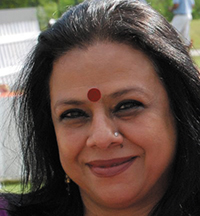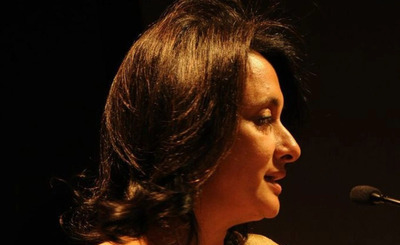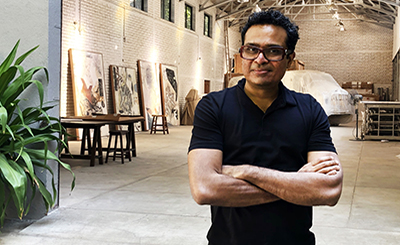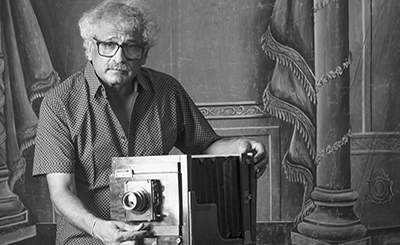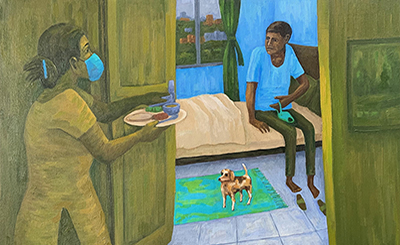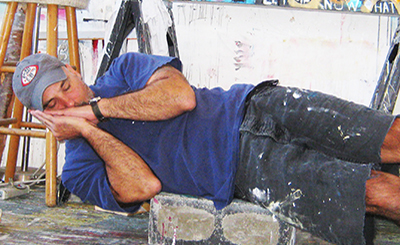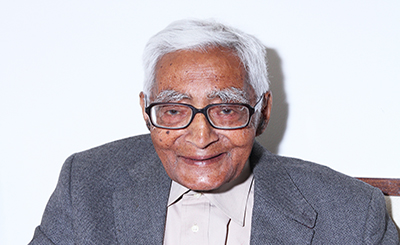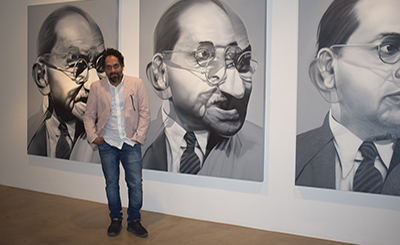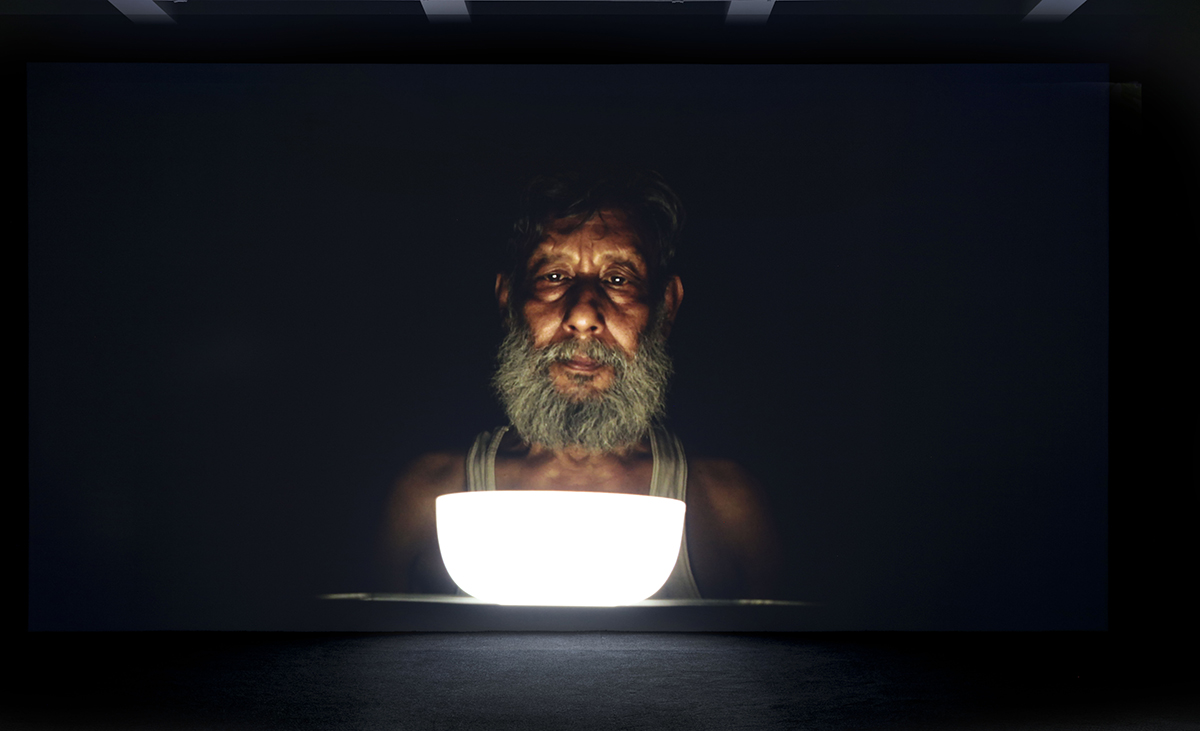
An installation from Such a Morning (2017), a modern parable about two people’s quiet engagement with truth. Photo: Ishara Art Foundation
Exploring social and political matters, filmmaker Amar Kanwar speaks eloquently of silence and asks: “What happens if many kinds of silence come close to each other? Then, how to listen, how to see?” As the world struggles with self-isolation and exile, the time has come surely when we must purge the environment of all that is negative and corrosive. Amidst the intense beauty of Kanwar’s frames is the sense of acute aloneness, the memory of home, of the fundamental desire for the freedom of one’s spirit and soul. The artist believes that “it is only through poetry that you understand history and the future.” The haunting music and ‘lingering footage’ form an ethereal backdrop against which stories of utmost cruelty unfold, the oral testimonies speaking of unimaginable tragedies wreaked upon innocent people. Kanwar’s voice and documentation of anguish and violence must be heard; he has been dwelling on the environmental collapse for a long while now. Today, more than ever, it is important to hear him speak.
Kanwar is presently exhibiting two solo projects in a landmark collaboration between NYUAD Art Gallery and Ishara Art Foundation in Dubai. Ishara has been committed to developing partnerships, contributing to institutional development in the Gulf and South Asia earlier. With Kanwar, there are plans afoot of further creating a new Curriculum for Studies into Darkness.
A brief note on the two exhibitions: Such a Morning (2017) is a modern parable about two people’s quiet engagement with truth. It navigates multiple transitions between mathematics and poetry, democracy and fascism, fear and freedom. In the cusp between every moment into new potencies. Each character seeks the truth through phantom visions from within the depths of darkness.
The Sovereign Forest (2011) attempts to initiate a creative response to our understanding of crime, politics, human rights and ecology. The validity of poetry as evidence in a trial, the discourse on seeing, on compassion, justice, and the determination of the self — all come together in a constellation of films, texts, books, photographs, seeds and processes.
At documenta 14, where we had watched Such a Morning, the audience had been riveted by your fictional narrative which centres around two characters who inhabit a world that is imaginary and breathtakingly beautiful. As the camera slowly pans over the faces on screen, one could well be asking like the artist : 'What is that lies beyond, when all arguments are done with? How to reconfigure and respond again?' In so many ways the film is reminiscent of present times,when we are all in self isolation, like the mathematics professor. Almost like a prophecy the film exists in different time zones, including the present. Maybe the future, even?
Yes that was my impulse to make this film. When you live in such a situation where you cannot see all the parts of the violence, some of it becomes continuously invisible and the rest of the violence becomes normal. You come to terms with it, you accept it, you forget, you adjust, and you live with it. Such A Morning is about trying to understand this, about trying to search for a way out of this situation, this state of mind. I found it difficult to make sense of this silent desire for violence, this unshakeable prejudice and our bewilderingly selective indifference. I found it difficult to argue anymore. To attempt to convince and to keep listing the evidence of the crimes, presenting the counter facts, the possibly true narratives or even taking the enlightened position of telling.
I felt the need to step back a bit, to reconceive and reconfigure another response. I wondered what would I see if I were to enter into the heart of this darkness? What could be the vision from within a zone of non-vision? This, therefore, is the context of Such a Morning. So the film was about exploring something while making, not fully scripted before and then executed later, but lived with and nudged along as signs emerged.
In many ways the professors’ experiences of isolation and hallucinations are similar to the present virus crisis, where we are now forced to retreat, isolate, conserve and reconfigure.
Regarding different time zones, yes, the narrative was constructed also on the hypothesis that experiencing the oscillation of time may create a unique state of mind. The author and the characters all tell the story and exchange roles seamlessly. All speak to each other even if in different times until you reach a zone where suddenly all times are valid. What you see could be being recounted as if in the past though it seemed to be happening in the present, but perhaps was a vision of what might come, what lay ahead.
Year later, at Kiran Nadar Museum of Modern Art, it felt surreal to actually walk around the rusted train coach where so much of the story had unfolded. What happened to the professor you wondered, did he return to civilisation or abandon it completely as he wandered off somewhere?
The professor finally began to reconnect with the world towards the end of the film. He begins by writing four letters. The first one is to the chancellor of his university where he writes about 49 kinds of darkness’s. And the need to open them up, relearn so as to enable new ways of teaching and living.Subsequently he writes to his colleagues, his students and also to the children who used to live in his street. So he does return but in his own way.
'Imagine nineteen sheets of paper floating forever in the wind.Imagine the simultaneous viewing of multiple time. …Time parallel and co-existing in two geographical memories.' Tell us how the idea of
the Letters became a part of this project, adding a unique dimension to it.
Even though the film ended, the story didn’t. It changes form and continues on beyond the film. The professor kept writing, he wrote his fifth letter which was directed to everyone, his sixth had no words and could be understood by only a few, his seventh letter was finally an invitation to come together in a bamboo forest on the slopes of a hill. Here the professors indicates what the 49 darkness’s could be and how they could be unraveled.
The meeting takes place inside the forest, which had been planted in such a way that it had formed into a huge endless structure with corridors, rooms, gardens and even a large hall. Some parts were filled with light, shade and patterns and others were damp and dark with streams visible and flowing under.
The letters exist in an installation along with the film in multiple forms of paper, text, light and image. The conversations that now begin form the basis of a research project with diverse artistic, pedagogic, metaphysical and political collaborations.
'When a film is not a document,it is a dream….At the editing table,when I run the strip of film through,frame by frame,I still feel that dizzy sense of magic of my childhood.' (Ingmar Bergman). Going back to early times,please tell us about your initial work.
Childhood repeats and plays out in multiple forms, sometimes we know it and at times it functions independently. Each film is a saga, to go back specifically means to write an autobiography, which is not possible here. Also there are too many autobiographies anyway.
Life has become divided into chapters, with films being markers; before, during and after. Perhaps what is appropriate, in response to your question, is to say that as one grows one gets attenuated in a certain way.You forget what you’ve forgotten. In the tedium and pain of every film, almost always, one suddenly finds a bit of voice and therefore the realization that you had lost it.
The chance of a possibility appears, of that magic or even the thrill of saying something in a way that you’ve never said before.
Is an illusion less real than a fact? Which vocabulary is most appropriate for a dream? How can a pamphlet be a poem, a poem the story of a murder, the murder then recalled as a ballad? How can the ballad become an argument, and the argument become a vulnerability, the expression of which might negate the argument or instead eventually shift all positions?
You have worked in the North East extensively, especially in Manipur. Tell us how it was to work with legends like Sabitri and Kanhailal.
Kanhailal and Sabitri are unique individuals … very different personalities. One measured, critical and constantly probing and the other a magician of the mind, body, emotions and multiple imaginations. They connected with diverse worlds, different vocabularies and opened up many routes into the body. They also shared this gift with great generosity. I was even just grateful for their existence, or to be with them whenever possible. I recall once Kanhailal asked me to say something about my work. At the end of a brief description he kept silent and just said let’s sleep and talk tomorrow. The next day he didn’t say a word until the evening, when he asked if I was willing to show some work. We then set up a screening of a few films in an open field with a mixed audience of several villagers, passerby’s and the theatre group, till late in the night. Again he said nothing afterwards. The following day he spoke about abstractions and indigenous cultures and reinterpreted some of my films in his own way.
Somehow it was the most graceful and welcoming embrace that I had ever received. And working with him thereafter became simple and filled with a certain unspoken mutual affection and trust that is difficult to describe. Sabitri, could at times, seem like a being from another planet. One early morning, I was brushing my teeth by a little stream. I saw Sabitri walking past. She suddenly caught my eye, an invisible force in her glance [that I still wonder about ]made me drop everything, push a half asleep crew to join me with the equipment and we stumbled behind her in our pajamas and as she marched off into the forest.
In a few minutes, we were inside a cluster of trees and she spontaneously burst into a breathtaking performance for the next 45 minutes …she began with loud calls, powerful sounds that came out as if from inside the earth, sounds that enveloped every tree, the sky and all of us - she then performed [ a part from Mahasweta Devi’s story] the scene of Draupadi disrobing and confronting her attacker. All of this at 6: 30 in the morning, unscheduled, unplanned, in what had seemed to be just a morning stroll. We filmed continuously and moved as if it was choreographed long before. That sequence changed The Lightning Testimonies permanently, gave it a power and direction that released me. Later I realized that I don’t have to speak much anymore. I had just met an unbelievable force that would lead and show the way forward. They will both live forever in the hearts of many people.
The Sovereign Forest is an ongoing response to politics, human rights and ecological crisis. In the film you have documented the industrial interventions that have drastically transformed Odisha's landscape brutally, paying no heed to the existing tribes who have been living there for hundreds of years. Each frame captures a moment of such acute & immense beauty that it is easy to forget for a while that there is violence and exploitation happening simultaneously. One is tempted to ask isn't the beauty too overpowering or distracting?
Yes, over powering and therefore distracting from what? From the violence and exploitation? Of which there is enough evidence anyway? And enough that has existed for a long time? Which narrative would you prefer? A suffering narrative creates suffering fatigue. A violence narrative creates pain, outrage and guilt.
A factual narrative becomes didactic and tedious? A beautiful narrative becomes distracting from real issues? So a balance is needed? A carefully calibrated balance so as to create the perfect combination of empathy and enlightenment? Could the most painful of moments exist in the most abstract of forms? Could the truth hide in the diversion, the tangential, the evasion? Could the gaps and silences in between words be what is really said rather than what is actually spoken or heard? Could a part give you a better sense of the whole?
It is hard to understand that in the last decade, we have had roughly 2,00,000 suicides by farmers. Unofficial figures are perhaps a lot more. But still, two lakh or more farmers have killed themselves in India. The scale and meaning of this is hard to comprehend. What’s also hard to accept is that there has been no political force of any kind, no civil society initiative, no group of us good people who have brought this State or great nation to a grinding halt because of these suicides. Nations have gone to war with each other for a tenth of this number killed, but we haven’t managed to stop this helpless voluntary mass murder. Which narrative will work for this situation? What happens if a crime continues to occur regardless of the enormous evidence available? Then is the crime invisible or the evidence invisible or are both visible but not seen?
My interim answer to this question was that perhaps we have lost the ability to comprehend the crime. Its scale, depth and the multiple meanings of the loss.Perhaps we need to step back even further. Maybe we have lost the ability to look as well? A certain kind of gaze creates a certain kind of comprehension, which creates a certain kind of compassion. The Sovereign Forest begins with a film that you are referring to – The Scene of Crime. What we do there is to step back and look at the land, at the scene of a crime about to occur. We see the land, and every thing that exits on it- water, grass, trees and prepare to mediate and look as deep as we can at the immense beauty and life force that exists here, that is about to be erased. Once we experience that, perhaps even find ourselves intertwined in that beauty of land, water, birds and animals – then we may be able to begin again. The Sovereign Forest, as an installation and exhibition, subsequently grows around that film, around the landscape of the scene of crime, and the beauty that you are referring to. As the exhibition grows it adds and accumulates evidence in various forms and vocabularies so as to comprehend the crime in deeper and more ways than one.
Perhaps given the state of the human condition and the scale of destruction so far, it is poetry that will have to be presented formally as evidence in the criminal trial.
Looking at the body of your work I am reminded of Bill Viola's lines: 'The most important place where my work exists is not in the museum gallery,or in the screening room, or on the television, and not even on the video screen itself,but in the mind of the viewer who has seen it.' In this context,my warmest congratulations to Ishara Art Foundation that they are showing these two brilliant projects for a longish duration of time. While some of us have had the opportunity to see your film installations in diverse places so many others have not, for them this will be the perfect chance.
Yes I do agree with Bill. I am often happy to show even to two people but this collaboration between Ishara and NYUAD Art Gallery is unique and a wonderful opportunity to share and speak to another region.
As a social activist who has been actively involved in taking a stand do you feel things are likely to change? The present scenario especially seems to offer very little hope, what gives you the sense
of purpose?The will to go on?
Sometimes we discover the will and urgency to live with grace and compassion only at the bottom of the pit!
Who are the artists or authors you draw inspiration from?
I am easily inspired. There is so much beauty and courage in the world. Enough for a hundred lives.
More from Arts
Comments
*Comments will be moderated
AmarGreat face Film maker
Bose Krishnamachari
Jun 16, 2020 at 04:31



